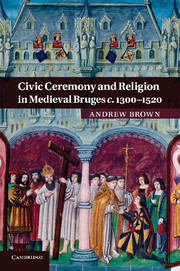Book contents
- Frontmatter
- Contents
- List of figures
- List of maps
- Acknowledgments
- List of abbreviations
- Note on currency and monies of account
- Introduction
- 1 The Holy Blood procession
- 2 General processions
- 3 Feast days and liturgical commemoration
- 4 Guilds: feast, festivity and public worship
- 5 Guilds and civic government
- 6 Civic charity
- 7 Civic ceremony, religion and the counts of Flanders
- Conclusion and epilogue: civic morality c. 1500
- Appendices
- Bibliography
- Index
- References
6 - Civic charity
Published online by Cambridge University Press: 03 May 2011
- Frontmatter
- Contents
- List of figures
- List of maps
- Acknowledgments
- List of abbreviations
- Note on currency and monies of account
- Introduction
- 1 The Holy Blood procession
- 2 General processions
- 3 Feast days and liturgical commemoration
- 4 Guilds: feast, festivity and public worship
- 5 Guilds and civic government
- 6 Civic charity
- 7 Civic ceremony, religion and the counts of Flanders
- Conclusion and epilogue: civic morality c. 1500
- Appendices
- Bibliography
- Index
- References
Summary
Next to St Basil's chapel containing the Holy Blood relic, and near the scepenhuis in the burg, lay the Dark Room. The building had once been part of the Steen, the count's castle, but by the early thirteenth century it was functioning as a prison. It had acquired its lugubrious name by 1303. Its history as a prison is appropriately obscure; sources concerning its role as a place of punishment do not survive much before the fifteenth century. Some of its functions are clearer at an earlier date. Like other buildings in the burg, it had long been under municipal authority, governed by two steenwarders who were directly appointed by the town council. At one level, it was thus an expression of communal autonomy from comital authority over certain aspects of justice. At another, it gave material form to the ability claimed by civic government to maintain social order in the town. It was also an institution that enshrined other aspects of civic authority, including those of a more sacred kind. The Dark Room dispensed charity as well as punishment. Comforting prisoners was traditionally one of the seven corporal works of mercy, and from the mid fourteenth century, as we shall see, the charitable provision that the Dark Room offered its inmates increased in a number of ways.
- Type
- Chapter
- Information
- Civic Ceremony and Religion in Medieval Bruges c.1300–1520 , pp. 195 - 221Publisher: Cambridge University PressPrint publication year: 2011



